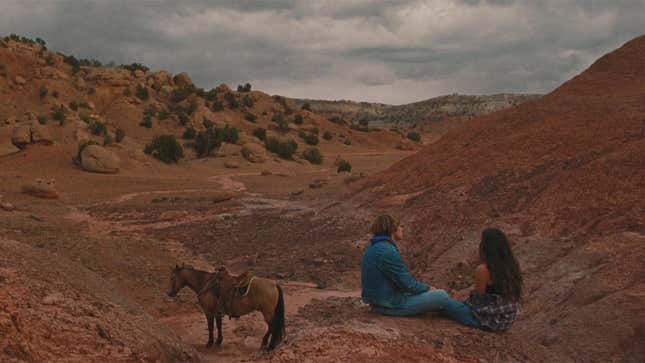
There has long existed a link between cowboy and queer culture, at the very least along aesthetic lines: Assless chaps, skin-tight denim and “riding bareback” transmit an innate homoeroticism. Cinema also boasts a fascination with queer cowboy narratives, most famously with Ang Lee’s devastating Brokeback Mountain and Jane Campion’s recent prairie period drama The Power Of The Dog. Pedro Almodóvar took a stab at his own gay Western with the 2023 short Strange Way Of Life (produced in part by fashion house Yves Saint Laurent) while Anna Kerrigan follows a trans child infatuated with an idealized gaucho lifestyle in her 2020 film Cowboys. The latest entry into this canon, Luke Gilford’s debut feature National Anthem, depicts queer rodeos and drag shows in rural New Mexico, but feels rough around the edges when contextualizing its central queer oasis amid the broader homophobic climate currently consuming American politics and culture.
21-year-old Dylan (an excellent, if underwritten, Charlie Plummer) works odd construction jobs in order to support his mother Fiona (Robyn Lively) and young brother Cassidy (Joey DeLeon). Often spending her meager pay as a hairdresser on alcoholic benders, Fiona effectively renders Dylan as the sole breadwinner. Her refusal to commit to sobriety also means that he is essentially raising Cass, often tasked with ensuring the kid’s health and happiness, as well as taking responsibility for his oddly charming pet chameleon. A lanky, defacto “pretty boy,” Dylan is generally ill at ease working beside the toxic macho men that tend to frequent this line of work. When he’s picked up by Pepe (Rene Rosado) to work a gig on his ranch, he’s pleasantly surprised to find himself tasked with manual labor on a queer commune. Dylan immediately notices Sky (Eve Lindley), a gorgeous trans woman donning an aquamarine gown and beat-up cowboy boots. Eventually, he spends more time hanging out on the ranch than working, resulting in a love triangle between the supposedly “open” Pepe and Sky that challenges his personal perception of love, sex, and community.
Adapted from his monograph National Anthem: America’s Queer Rodeo, Gilford’s film still doesn’t feel authentically rooted in the subculture that he spent the better part of a decade photographing. There are several scenes where characters attend markedly queer rodeos (with the actors filmed among genuine attendees), yet National Anthem feels removed from the real faces and stories Gilford documented while making his photobook. For a story that was ostensibly mined from real-life interviews and observances, the script—co-written by Gilford, David Largman Murray, and Kevin Best—is confoundingly riddled with clichés and under-baked plot points. Most characters are running away from generically unsupportive home lives; meanwhile Dylan is saving up for a RV for his own independence, with no internal conflict presented over leaving Cass with an unreliable caretaker. There’s a lack of diversity and interiority among the film’s characters.
National Anthem also refuses to engage with the political significance of its setting. While there are several instances in the film of harassment and intolerance toward queer locals, New Mexico actually boasts wonderful protections for gay and trans individuals of all ages. It’s considered a “sanctuary state” for trans youth and adults alike, allowing for gender-affirming care and treatment even for out-of-state visitors. Conversion therapy has been banned since 2017, and the notorious “gay panic defense” was similarly abolished in 2019. It makes sense why an idyllic queer commune could exist in such an environment, but it’s perplexing that these unique circumstances aren’t ever articulated, particularly when neighboring states such as Texas, Arizona, and Utah are comparatively far less welcoming.
Despite these nagging issues, Plummer breathes life into the film, his every action and word effortlessly capturing the turmoil of an otherwise paltry character. Even so, the similarities between National Anthem and Andrew Haigh’s 2017 gem Lean On Pete—in which Plummer also stars—are somewhat glaring. Both focus on a troubled, soft-spoken young man who lives with a single parent and finds solace in an unexpected job on a ranch (both also involve moments with horses that pull on the heartstrings). Instead of adding more depth to Plummer’s role, it appears that the filmmaker sought to simply channel the brilliance of the actor’s past performance. While he plays Dylan with a cool—if somewhat endearingly awkward—tenderness, there’s a troubling lack of personal substance to the character.
Though lushly lensed by cinematographer Katelin Arizmendi (Monica, Swallow), there isn’t much under the quietly glam veneer of National Anthem. Had Gilford hewed closer to the everyday folks that find freedom in queer rodeos, a more varied tapestry of this slice of subversive Americana would have shone through. Perhaps this is an unexpectedly salient analogy for the country’s paradoxical relationship to queer culture: We love to mine these stories for the sake of art, but tend to lose individual nuance along the way—resulting in the construction of boring clichés at best, and straw men at worst.